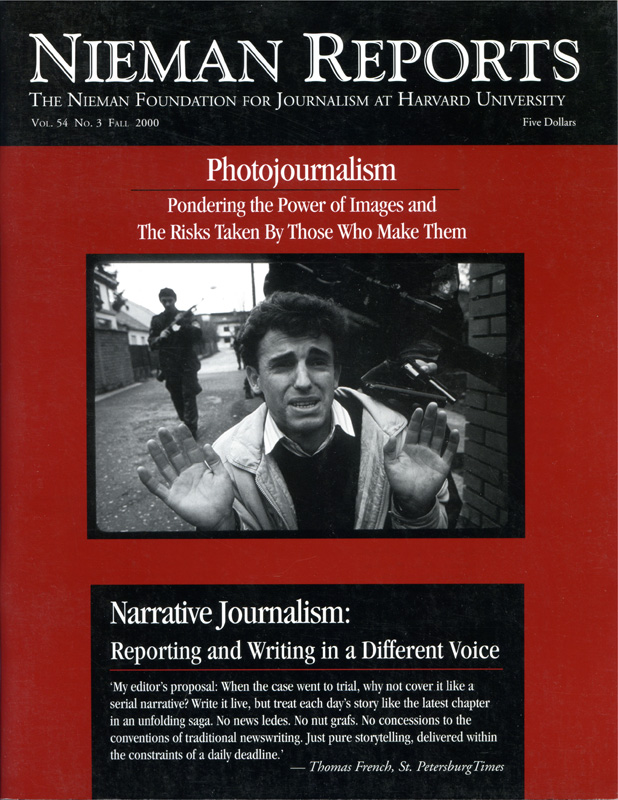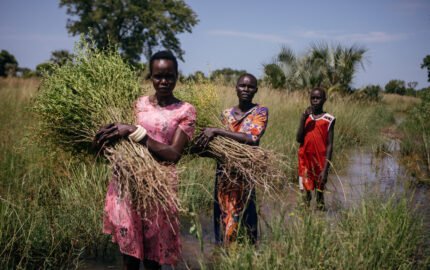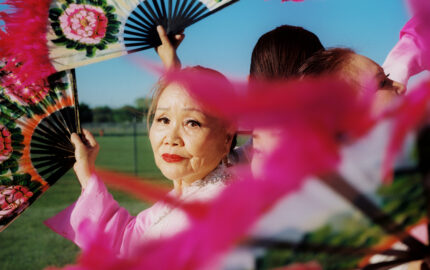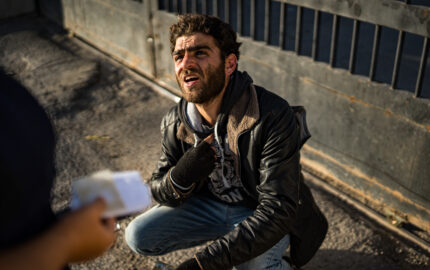
Photojournalism: Pondering the Power of Images and the Risks Taken by Those Who Make Them
James Nachtwey’s book “Inferno” is a collection of 382 photographs depicting the horrific brutality and suffering of people who are entrapped by war, famine or political unrest. Its publication offers an opportunity to reflect not only on his extraordinary and courageous career as a photojournalist but on how, in this time of visual onslaught, images such as these are absorbed and their messages acted upon.
At a May 2000 conference called “The World of Conflict,” co-sponsored by The Crimes of War Project and The Freedom Forum, former soldiers who now teach journalists how to assess risks while covering wars spoke about aspects of this training. Known as the Hostile Environments Training Course, it was developed with the help of journalists and is mandatory for every BBC reporter going into a conflict zone. Former Royal Marine Paul Rees, director of Centurion Risk Assessment Services Ltd., one of the companies which does this training, and Jon Seward, also a former Royal Marine and Centurion’s chief instructor, spoke about the program. Edited excerpts from their remarks follow.
John Owen [director, The Freedom Forum European Center]: “Britain has become the center for what is known as the Hostile Environments Training Course, a rather large mouthful that says basically that journalists are being given the benefit of courses that I think most people feel are helping to keep them alive, or at the very least giving them many more smarts in the field about how to stay alive.
“The courses came about in part because the BBC took leadership in this area after one of their journalists, John Schofield, was killed in Croatia. We now have training courses developed by two major groups, Centurion and AKE, and the leading group, Centurion, is with us today.
“[I]t is often said that journalists are being taught to be soldiers, that this is sort of journalists become soldiers of war. And articles written about these training courses often make this mistake as well. The critical point is that these courses were developed by journalists in conversations with these former soldiers. The important point is the control is rested in the hands of the journalists. And when you hear that these are courses teaching journalists how to be soldiers, please try to correct the record.
“The other thing is what is happening with Centurion and the other group, AKE, is that these courses are for the first time being taught to local journalists. Going back to late November of 1998 in Tirana, Albania, 20 journalists were brought together and given courses that gave them some of the expertise that Western journalists get before they go off to the war zones. It is a policy now in the BBC that no journalist can go to a conflict zone unless they’ve been through this course.
“The local journalists who took that course in Albania told me later that they thought it had kept them alive. One journalist said this because they were able to identify land mines in their treks getting out of Kosovo. Another pointed to the first-aid training that they got. They said that when one of their colleagues was hurt, they were able to apply what they learned in the course.”
Paul Rees [director of Centurion]: “[W]e were approached from the BBC when I was still serving in the Royal Marines and asked if we could come up with a program for journalists for hostile environments. What was the hostile environment at that time? Well, at the time it was the former Yugoslavia. They wanted to do something about safety training. So with our knowledge from being ex-Marines and with the knowledge of journalists, senior journalists, senior media workers, camera crews, reporters, we have come up at the present time with a real good course for journalists…. Every time somebody signs up for the Hostile Environments Course, they think on the first day it’s flak jacket on, helmet on, and we’re off. It’s not. It’s a general awareness course that covers everything from personal security, from you walking down the street in any city through to the full-blown war zone where the bullets and the bombs do happen.
“We are firm believers from our past experience that we only learn or we learn greater when we’re on the ground and we’re under pressure, when we have to go to these scenarios, get our hands bloody. So that’s why our course, a lot of it, is outside.
“We talk about the importance of identifying hazards to reduce the risk to the lowest possible level. Flak jackets, do you take them, do you not take them? Again, that is up to the individual. Some people may not even be given them, cannot afford one, they have old ones—are they worth taking? These are the risks that they are trying to assess prior to going, and we discuss all of these all the way through.
“[I]t’s all to do with risk assessment, and I do emphasize on the course we don’t tell you what’s black or white, it’s just to give you the options. The way we give them the options is show hundreds of clips and let the people in the course be the judge of what can happen. So when we go on and do the scenarios, they have loads of other options to think about.”
RELATED ARTICLE
"‘Basically We’re Alone. Left Up to Our Own Wits.’"
- A Panel of War Photographers
Jon Seward, Centurion’s chief instructor, began his remarks by praising the work of the three photographers who spoke earlier at the conference about the calculated risks they take to do their job in the midst of conflict.
“I’d like to say, as a former professional serviceman and having served throughout the world in various conflicts and probably the longest current terrorist threat in the Western world at the moment, I take my hat off to the three photographers [Haviv, Knight and Lehman]. They have my utmost respect. Considering the fact that I had a weapon in my hand all those times and they just basically had their wits, their common sense, and maybe dare I say their sense of humor, undoubtedly they have the greatest of respect.
“When we talk about ballistics, what do we mean by ballistics? Basically we mean anything, whether it be shoulder launched, held in your hand, or fired from artillery, tanks, aircraft even down to cruise missiles. When you look at the advent of technology where we can be hit from, you’re talking about ranges anything out to 300, maybe 400 miles away. If you’re in the wrong place at the wrong time, you’re not going to really appreciate that until that cruise missile can come up a Beirut street and turn left or whatever the case is.
“Fundamentally, though, what we actually look at is how the small arms affect you as the individual on the frontline. What we try to make you appreciate is the fact that wherever you are the target, if you are the target, [we want you to] have an appreciation of what’s being fired at you and from where it’s being fired at you. And if you are in the actual killing zone itself, [we want to] give you an appreciation of what these weapons can do and at the same time what you can lie behind, sit behind, crawl behind, or whatever the case is, to avoid being hurt, even if it’s only for a couple of minutes or a couple of seconds in some extreme cases. Then, hopefully, we are giving you some sort of appreciation of where you can and, more importantly, where you cannot go, and if you go into that area, how long you can actually stay there for.
“We show you exactly what you can hide behind and what you can’t hide behind by taking the journalists down to a range just outside London. We actually fire small-arms ammunition, whether it be from handguns, shotguns, assault weapons, machine guns, sniper weapons, to give you an appreciation of what will stop a round. Alternatively, particularly with machine guns, [we show] how long you can afford to stay behind a brick wall, a house door, or whatever the case is before those rounds actually penetrate and come through on top of you.”
John Owen [director, The Freedom Forum European Center]: “Britain has become the center for what is known as the Hostile Environments Training Course, a rather large mouthful that says basically that journalists are being given the benefit of courses that I think most people feel are helping to keep them alive, or at the very least giving them many more smarts in the field about how to stay alive.
“The courses came about in part because the BBC took leadership in this area after one of their journalists, John Schofield, was killed in Croatia. We now have training courses developed by two major groups, Centurion and AKE, and the leading group, Centurion, is with us today.
“[I]t is often said that journalists are being taught to be soldiers, that this is sort of journalists become soldiers of war. And articles written about these training courses often make this mistake as well. The critical point is that these courses were developed by journalists in conversations with these former soldiers. The important point is the control is rested in the hands of the journalists. And when you hear that these are courses teaching journalists how to be soldiers, please try to correct the record.
“The other thing is what is happening with Centurion and the other group, AKE, is that these courses are for the first time being taught to local journalists. Going back to late November of 1998 in Tirana, Albania, 20 journalists were brought together and given courses that gave them some of the expertise that Western journalists get before they go off to the war zones. It is a policy now in the BBC that no journalist can go to a conflict zone unless they’ve been through this course.
“The local journalists who took that course in Albania told me later that they thought it had kept them alive. One journalist said this because they were able to identify land mines in their treks getting out of Kosovo. Another pointed to the first-aid training that they got. They said that when one of their colleagues was hurt, they were able to apply what they learned in the course.”
Paul Rees [director of Centurion]: “[W]e were approached from the BBC when I was still serving in the Royal Marines and asked if we could come up with a program for journalists for hostile environments. What was the hostile environment at that time? Well, at the time it was the former Yugoslavia. They wanted to do something about safety training. So with our knowledge from being ex-Marines and with the knowledge of journalists, senior journalists, senior media workers, camera crews, reporters, we have come up at the present time with a real good course for journalists…. Every time somebody signs up for the Hostile Environments Course, they think on the first day it’s flak jacket on, helmet on, and we’re off. It’s not. It’s a general awareness course that covers everything from personal security, from you walking down the street in any city through to the full-blown war zone where the bullets and the bombs do happen.
“We are firm believers from our past experience that we only learn or we learn greater when we’re on the ground and we’re under pressure, when we have to go to these scenarios, get our hands bloody. So that’s why our course, a lot of it, is outside.
“We talk about the importance of identifying hazards to reduce the risk to the lowest possible level. Flak jackets, do you take them, do you not take them? Again, that is up to the individual. Some people may not even be given them, cannot afford one, they have old ones—are they worth taking? These are the risks that they are trying to assess prior to going, and we discuss all of these all the way through.
“[I]t’s all to do with risk assessment, and I do emphasize on the course we don’t tell you what’s black or white, it’s just to give you the options. The way we give them the options is show hundreds of clips and let the people in the course be the judge of what can happen. So when we go on and do the scenarios, they have loads of other options to think about.”
RELATED ARTICLE
"‘Basically We’re Alone. Left Up to Our Own Wits.’"
- A Panel of War Photographers
Jon Seward, Centurion’s chief instructor, began his remarks by praising the work of the three photographers who spoke earlier at the conference about the calculated risks they take to do their job in the midst of conflict.
“I’d like to say, as a former professional serviceman and having served throughout the world in various conflicts and probably the longest current terrorist threat in the Western world at the moment, I take my hat off to the three photographers [Haviv, Knight and Lehman]. They have my utmost respect. Considering the fact that I had a weapon in my hand all those times and they just basically had their wits, their common sense, and maybe dare I say their sense of humor, undoubtedly they have the greatest of respect.
“When we talk about ballistics, what do we mean by ballistics? Basically we mean anything, whether it be shoulder launched, held in your hand, or fired from artillery, tanks, aircraft even down to cruise missiles. When you look at the advent of technology where we can be hit from, you’re talking about ranges anything out to 300, maybe 400 miles away. If you’re in the wrong place at the wrong time, you’re not going to really appreciate that until that cruise missile can come up a Beirut street and turn left or whatever the case is.
“Fundamentally, though, what we actually look at is how the small arms affect you as the individual on the frontline. What we try to make you appreciate is the fact that wherever you are the target, if you are the target, [we want you to] have an appreciation of what’s being fired at you and from where it’s being fired at you. And if you are in the actual killing zone itself, [we want to] give you an appreciation of what these weapons can do and at the same time what you can lie behind, sit behind, crawl behind, or whatever the case is, to avoid being hurt, even if it’s only for a couple of minutes or a couple of seconds in some extreme cases. Then, hopefully, we are giving you some sort of appreciation of where you can and, more importantly, where you cannot go, and if you go into that area, how long you can actually stay there for.
“We show you exactly what you can hide behind and what you can’t hide behind by taking the journalists down to a range just outside London. We actually fire small-arms ammunition, whether it be from handguns, shotguns, assault weapons, machine guns, sniper weapons, to give you an appreciation of what will stop a round. Alternatively, particularly with machine guns, [we show] how long you can afford to stay behind a brick wall, a house door, or whatever the case is before those rounds actually penetrate and come through on top of you.”


